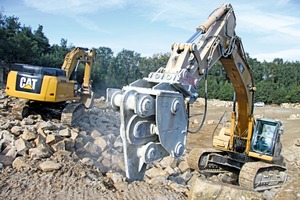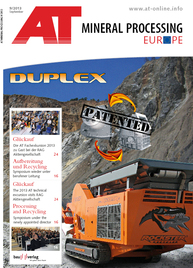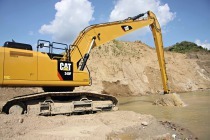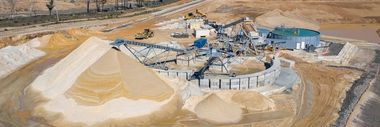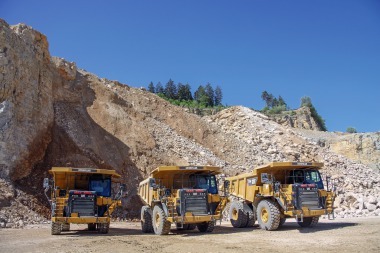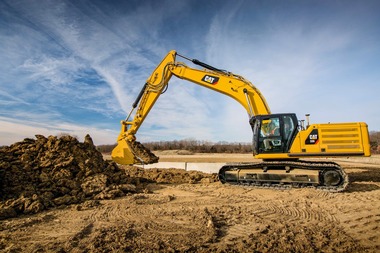Quarrying with the help of CAT construction machines
Ibbenbüren sandstone is a quartz rock that has been used as a popular building material for many centuries. Typical material properties: it is medium- to coarse-grained, robust and not particularly vulnerable to weathering. Its colour varies between buff, grey and brown shades. One family business that has been quarrying this rock for over sixty years – now in the third generation – is Westermann GmbH & Co. KG. The company also extracts sand and clay shale. Everything from the sandstone quarry is used. The sandstone is processed to armourstone, sand and gravel for gardening, path and road construction as well as washed sand for sports grounds and filters. The clay shale is bought by brickworks. Clay is used for sealing layers in landfills; peat is bought in, mixed with clay shale and sold as potting soil in commercial horticulture.
At regular intervals of five years, the company renews its fleet of machines. CAT machines make up a large part of this. Main supplier for construction machines is the Zeppelin branch in Osnabrück, through which the construction machines are also serviced. If investments are due to be made or any technical questions arise, Carl Brinkmann, Senior Sales Representative at Zeppelin’s Osnabrück branch, advises the company owner Andreas Westermann, Managing Director Ludwig Menger and Operations Manager René Giese. Together they have thought up a solution for the CAT 330DL hydraulic excavator, which has so far been an exception when it comes to material extraction. The CAT 330DL has not been fitted with a shovel, but with a ripper – similar to a caterpillar. This allows the machine to penetrate into the material better and rip into rock interspersed with layers of clay (Fig.).
In 2012 the extraction volume was adjusted to the market situation. Today Westermann extracts 500 000 t per year. The CAT 385CL hydraulic excavator, which has been firm part of the fleet since bauma 2010, makes this production volume possible. Before the construction machines can extract the sandstone, they have to remove the overburden. For this, boreholes are drilled at a depth of 2.5 to 3 m, to blast the rock and loosen it up. However, the quarry planning must take a crucial special aspect into account. Below the quarry, coal used to be mined. After the “West Field” was closed, the mine water started to rise again. That means: it is necessary to quarry over the width rather than into the depth. This is where the CAT 385CL comes into play and can start with the loading of clay shale or sandstone onto CAT dumpers such as one 771 or two 772s.
The trucks take the material to the primary crusher. The raw material is pre-crushed to a size smaller than 450 mm at the extraction site. On a belt conveyor the material is then transported to the screening and sizing plant at a distance of around one kilometre away, where it is sized. All materials are dry-stored in silos with a capacity up to a thousand tonnes. The trucks are loaded by computer-controlled belt conveyors. A fleet with 16 trucks with trailers is used for transport. The products are not only transported to customers on the road, Westermann has its own loading facility at the branch canal. This facility was reconditioned in 2000 and extended to a loading draft of 2.50 m. The material is delivered on a truck and dumped on a chute direct onto the barge.

